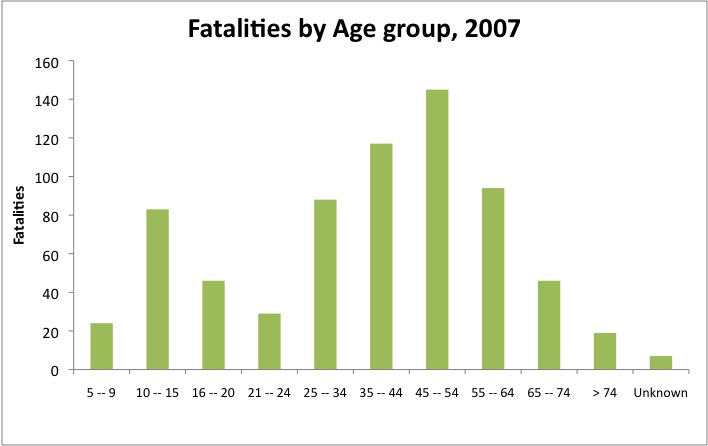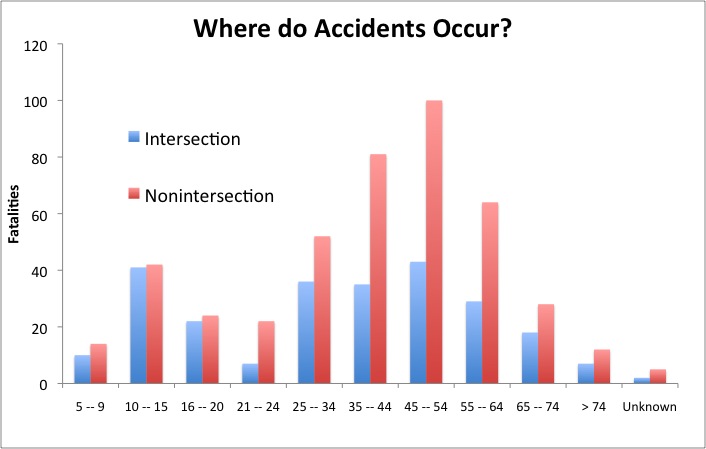Bike Fatalities, by age and location
It seems like everyone knows someone who was hit by a car in the last 3 months. I don’t know what it is about fall, but cyclists are dropping like flies, and so I’ve been thinking about bike fatalities. I dug up some numbers, and I’d like to share some graphs.
Above is the breakdown for all of the cycling accidents in 2007 (most recent numbers, as far as I know). Most people I know that were hit were in the 25-34 age group, but the most fatalities occurs in the 45-55 age group. Strange isn’t it? I’d be curious to see if this is due to an increase in accidents, or just the fact that their middle aged bodies can’t handle what a younger body could. In other words – this might be a an age where people are still active, but they don’t just roll off the hood of a car like they used to. So, be careful out there, my middle aged friends.
The next question someone might ask is “Where are these accidents taking place?”. They could occur anywhere – and indeed insurance companies and the national highway traffic administration keep track of this. The simplest distinction is between an accident that occurs in an intersection, and an accident that occurs in a non-intersection.
Here is where things get interesting: this age peak in fatalities for the 45-50 year olds virtually disappears when looking at accidents that only occur in intersections. So, this bias is due to an increase in non-intersection related accidents. I don’t know exactly why this could be. If the above hypothesis is correct – and this effect is due to an increase in fragility, rather than an increase in accidents – then perhaps there are more non-fatal non-intersection accidents for 21-24 year olds. These non-intersection accidents could be less severe for the young and rubber boned, but just fatal enough for the middle aged.
I don’t know if this is a fair assumption, but I’ve chosen it as a starting point. Whatever the truth actually is, we all have to be careful out there.


 4 Comments
4 Comments
I’m not sure about your hypothesis. It’s possible, but I think you need either the rate of deaths in each demographic OR information about the number of injuries (and therefore the proportion of deaths/injury) to back it up.
Hi Aaron, you’re right that I need more information, but a general “rate of death” doesn’t seem relevant here. I see what you’re getting at, but since the fragility hypothesis only concerns getting hit by a motor vehicle, then a general death rate will not be of any concern.
Information about the injury rate, however, would be very useful. This increase in cycling fatalities could be caused by an increase in accidents. The reason I went with the fragility hypothesis is that I can’t imagine any reason why middle aged men and women would get hit more often than 20 somethings.
I meant the rate of deaths per injury, sorry I wasn’t more specific.
I was thinking about the middle-aged folks and wondering if they do more rural riding.
I think we need more information before we can make a hypothesis here. For example, how does the rate of accidents/fatalities compare between men and women? In the UK, many more women than men are hit by cars at non-intersections because they are less confident on the bike, particualry if they are ‘returning’ cyclists. We also need to know whether there is a high uptake of new cyclists in middle-age. An analogy here would be motorcyclists: in the UK it has become fashionable for middle-aged men to relive their biking youth by buying expensive motorbikes when they have disposable income in middle age. They can’t handle the speed of modern bikes and they have accidents. My point is that if you take up cycling again in middle age after a break, you may well assume you know what you’re doing. But traffic is heavier and likely faster, you are less steady on the bike than you remembe; you are an accident waiting to happen. We need more detail!